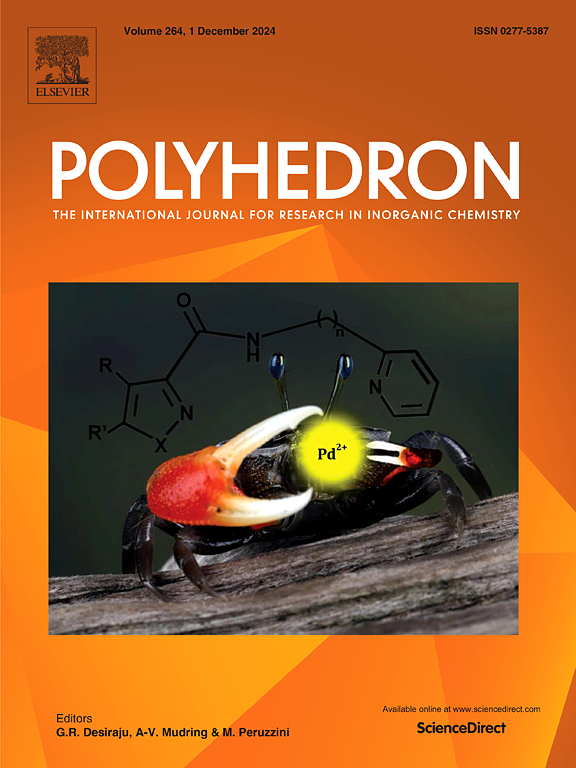Influence of ligand donation on charge transfer properties of cyanido-bridged binuclear Fe-Ru complexes
IF 2.4
3区 化学
Q2 CHEMISTRY, INORGANIC & NUCLEAR
引用次数: 0
Abstract
To investigate how the electron-donating ability of the ligand influence the metal-to-metal charge transfer (MMCT) in mixed-valence (MV) systems, a series of asymmetric binuclear cyanido-bridged complexes CpMex(dppe)FeCNRu(bimpy)(PPh3)(NCCH3), N[PF6]2 (x = 1, 3, 4, 5; N = 1, 2, 3, 4; CpMe = methylcyclopentadiene; CpMe3 = 1, 2, 4-trimethyl-cyclopentadiene; CpMe4 = 1, 2, 3, 4-tetramethyl-cyclopentadienyl; CpMe5 = 1, 2, 3, 4, 5-pentamethyl-cyclopentadienyl; dppe = 1,2-bis(diphenylphosphino)ethane; bimpy = 2, 6-Bis(benzimidazol-2-yl)pyridine; PPh3 = triphenylphosphine), along with their one-electron oxidized products N[PF6]3 were synthesized and well characterized. In these MV systems, significant electronic interactions between the two metal centers were revealed by electrochemistry, crystallography, FTIR, UV–vis-NIR, and supported by the DFT calculations. The results showed that the MM’CT energy from the RuII to the FeIII increases as the electron-donating ability of the CpMeX ligands was enhanced with the addition of methyl substituents. Meanwhile, all the one-electron oxidized products N[PF6]3 belong to Class II systems.

配体给予对氰基桥接双核铁钌配合物电荷转移性质的影响
为了研究配体的给电子能力对混合价(MV)体系中金属-金属电荷转移(MMCT)的影响,研究了一系列不对称双核氰基桥接配合物CpMex(dppe)FeCNRu(bimpy)(PPh3)(NCCH3), N[PF6]2 (x = 1,3,4,5;N = 1,2,3,4;CpMe =甲基环戊二烯;CpMe3 = 1,2,4 -三甲基-环戊二烯;CpMe4 = 1,2,3,4 -四甲基-环戊二烯;CpMe5 = 1,2,3,4,5 -五甲基-环戊二烯基;dppe = 1,2-二苯基膦乙烷;bimpy = 2,6 -双(苯并咪唑-2-基)吡啶;合成了PPh3(三苯基膦)及其单电子氧化产物N[PF6]3,并对其进行了表征。电化学、晶体学、FTIR、UV-vis-NIR和DFT计算结果表明,在这些MV体系中,两个金属中心之间存在显著的电子相互作用。结果表明,随着甲基取代基的加入,CpMeX配体的给电子能力增强,从RuII到FeIII的MM′ct能量增加。同时,单电子氧化产物N[PF6]3均属于II类体系。
本文章由计算机程序翻译,如有差异,请以英文原文为准。
求助全文
约1分钟内获得全文
求助全文
来源期刊

Polyhedron
化学-晶体学
CiteScore
4.90
自引率
7.70%
发文量
515
审稿时长
2 months
期刊介绍:
Polyhedron publishes original, fundamental, experimental and theoretical work of the highest quality in all the major areas of inorganic chemistry. This includes synthetic chemistry, coordination chemistry, organometallic chemistry, bioinorganic chemistry, and solid-state and materials chemistry.
Papers should be significant pieces of work, and all new compounds must be appropriately characterized. The inclusion of single-crystal X-ray structural data is strongly encouraged, but papers reporting only the X-ray structure determination of a single compound will usually not be considered. Papers on solid-state or materials chemistry will be expected to have a significant molecular chemistry component (such as the synthesis and characterization of the molecular precursors and/or a systematic study of the use of different precursors or reaction conditions) or demonstrate a cutting-edge application (for example inorganic materials for energy applications). Papers dealing only with stability constants are not considered.
 求助内容:
求助内容: 应助结果提醒方式:
应助结果提醒方式:


